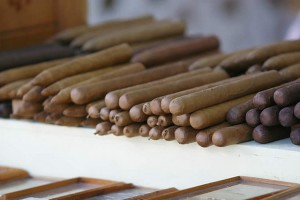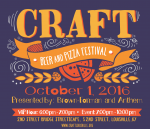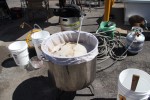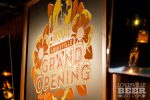 Tolerable front porch weather resumed in September this year, and temperate temps lasted well into October. Suddenly, as though gripped by an obscure internalized auto-pilot, I found myself queuing at various local cigar purveyors, and layering my humidor.
Tolerable front porch weather resumed in September this year, and temperate temps lasted well into October. Suddenly, as though gripped by an obscure internalized auto-pilot, I found myself queuing at various local cigar purveyors, and layering my humidor.
New Albany is fortunate in this regard. There’s Kaiser Tobacco, which has operated on Pearl Street for more than 175 years, and also Billow, celebrating a year in business on Market Street.
Billow’s strategic location is especially pleasing to the senses when those days when the planets are aligned. Just next to it is the Quills coffee shop, and across the street Habana Blues, a Cuban restaurant. Aromas of cigars, coffees, teas and spicy roasted meats can be pervasive in that area, reminding us of how very important our retained impressions of smell can be, combining with sights and sounds to conjure wonderful memories.
And then there’s beer.
—
In 1995, on a sunny fall afternoon in Antwerp, Belgium, we’d started drinking early at the Elfde Gebod (Eleventh Commandment) café, where religious statuary both sacred and profane lines the walls. The eccentric tableau is just creepy enough to be inspirational, so for those seeking a view of “Jesus with the head of a dog” while sipping Westmalle Tripel, the Elfde Gebod is just your kind of place.
Later that afternoon, my pot of North Sea mussels steamed in dry white wine was superb. Endless, graceful “bollekes” of locally brewed De Koninck amber ale were equally fabulous, and there remains a sneaking suspicion that we found Rodenbach on tap somewhere at a bar upstairs on the other side of the cathedral.
Belgium’s diamond capital is a city filled with food, drink and nightlife, and the specific reason why the memory of this particular day returned to me recently was a cigar, cradled in my hand, burning ever so slowly, emitting puffy smoke rings – the fruition of a long, patient process of growth, cultivation, harvesting, curing, hand rolling, packing and distribution.
It took me back to the conclusion of our Antwerp session so very long ago, because we ended the long day’s session at the famous beer bar called the Kulminator, where Dirk was featuring ten-year-old vintage dark ale called Breughel, brewed by a long defunct brewery (since then, it has been revived), as salvaged from a forgotten stash hidden in a friend’s garage.
Miraculously, the process of aging had been quite friendly to the Breughel. Oxidization offered a velvety patina of sherry-like nuttiness to concentrated fruitiness, on the order of plums, pecans and toffee. I drank one, ordered another, and lit an authentic Havana: The Romeo y Julieta Churchill, purchased a few days earlier at a tobacconist’s in Brussels.
At the time, I was quite sure it was the best cigar I’d ever smoked. Finely conditioned, properly humidified and boasting a clean draw and steady, stately, dead-even ash, it was full-bodied and unapologetic in flavor, and the sensory qualities of the tobacco were simply overwhelming. Not only that, I had a complex, nuanced beer to go along with the cigar. The match of power vs. power seemed ideal.
At the same time, as one who regularly enjoys good beer with good cigars, I must confess that at some level, doing so is counter-intuitive. Puffing on a cigar changes the way a beer tastes. Conversely, drinking a beer also changes the way a cigar tastes. Can partaking of beer and cigars together change the way both taste, but in a positive way, one modifying pleasurable aspects of each and yielding a harmonious, hedonistic whole?
I think so.
When given the chance to nip at a beer I haven’t previously tasted, my general inclination is to avoid cigar smoke; after all, the first Breughel in Antwerp went down before the cigar came out. This is a personal preference, and simple enough to keep straight. The point to me is that because quality beer and cigars both appeal to me, I’m likely to continue making simultaneous use of them, and with a wee bit of forethought, the experience can be enhanced.
—-
On the cigar side, the logical place to assess the range of pairing choices is the wrapper, which contributes much to the flavor profile and offers visual clues. Wrappers range from lighter to darker shades, with subtle, spicy notes common in the light wrappers and cocoa or chocolate hints noticeable as the color nears black.
Albeit imperfectly, these wrapper shades correspond to beer colors as a preliminary basis for pairing.
The base malt of beer is golden, with hues added through the use of specialty malts, which also provide flavors ranging from roast to espresso to wood smoke. Color alone doesn’t always indicate the strength and character of a beer, and it should be obvious that the lightest styles of beer won’t always pair well with tobacco even if the cigar is innately mild.
For instance, a golden-colored beer might be light and delicately hopped (Kolsch), medium-bodied, estery and phenolic (German Hefeweizen) or strong and malty sweet (Maibock). With a yellowish-brown Claro wrapper, Kolsch’s subtlety would be missed, and the assertive Maibock might overwhelm it. Among these three beer styles, a reasonable starting point might be Hefeweizen; a touch of clove and fruit for complementing the Claro’s spiciness.
Aggressively hoppy beers, including American Pale Ales and English ESBs, excel in the middle of the wrapper color range, especially Colorado (brown). Hops also can complement a cedar-like flavor component in cigars (sometimes gleaned from their modes of storage), but hoppy beers lacking a firm malt component, like an everyday Pilsner, often lack the heft to compete.
The greater the coffee, cocoa and chocolate content of the wrapper (Maduro and Oscuro), the less utility of either hops or spices, and far better the match with beers offering similarly dark character: Stouts, Porters, Belgian Dubbels, and any number of unclassifiable stronger, dark and blacker specialty brews.
As suggested long ago by my old friend Paul Mick, the residual sugar found in many bigger, darker beers serves as a levelling agent in the struggle for balance with fuller-bodied cigars. In a primal and purely axiomatic sense, the pinnacle of full-on-full pairings could well be oily, black Maduro cigars alongside bourbon-barrel-aged Imperial Stouts.
Of course, these musings will be familiar to cigar smokers with a taste for Port, and those already enamored of the wider world of whiskies. Kentucky’s legendary bourbon whisky pairs well with cigars because both possess woody flavors. The alcohol in the bourbon cleanses the palate; and the corn mash sweetness of the whisky balances the absence of sweetness in the tobacco. Or so it seems to me.
Indeed, the utility of experimentation never diminishes. So, what is your own strategy for beer and cigars?





